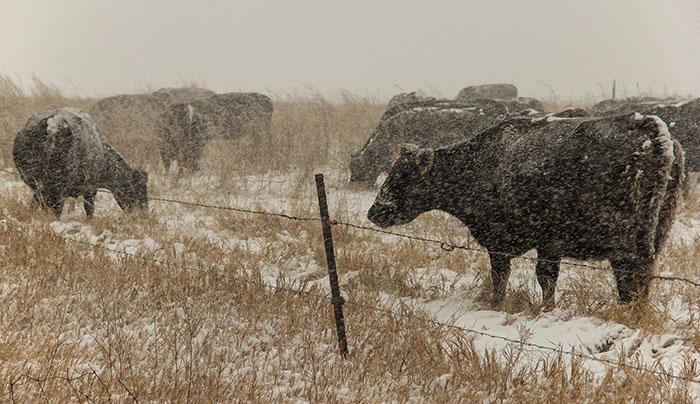Cattle need attention during winter storms |
| By Sydney Sleep |
|
|
|
Snow and ice storms are often a part of life for cattle grazing winter pastures in Northern states. For their owners, it means making those cattle as comfortable as possible and ensuring adequate nutrition. “Protection from wind is critical,” says Sean Kelly, South Dakota State University extension range management field specialist. In SDSU extension’s newsletter, iGrow, Kelly notes that if winter pastures lack protection such as draws or shelterbelts, temporary windbreaks are an alternative. According to Warren Rusche, SDSU Extension beef feedlot management specialist, reducing wind speed from 20 to 5 miles per hour or less reduces maintenance energy requirement as much as 30 percent per cow. Though producers are sometimes forced to adjust their feeding strategies during snowstorms or cold snaps, sudden diet changes may cause digestive upset. “Any changes made to a cow’s diet during and after a winter storm need to be done gradually so cattle have time to adjust,” Kelly says. To assure energy intake is adequate, most cattle grazing dormant winter pastures need their diet supplemented. The first limiting nutrient is protein. Energy is available in the fiber of lower-quality forage or hay, but extra protein is needed for the fiber to be utilized. The extra protein stimulates the microbes in the cow’s rumen to ferment and digest the fiber. This improves the amount and rate of digestion of low-quality forages. Therefore, the cow is getting more energy and nutrients from each pound of low-quality forage consumed. “A rancher can get in trouble when the cow’s diet is changed abruptly with a grain-based energy supplement such as corn,” Kelly says. High-starch energy supplements such as corn are low in protein and cause a drop in rumen pH, resulting in changes in the microbe population. The fiber-digesting microbes decline in population, leading to reduced forage intake and digestibility. Even though additional energy is available from corn, there may be no growth in total energy available because the cow consumes and digests less forage. Following the storm, additional supplementation may be needed to maintain body condition. Kelly suggests that a fiber-based protein supplement be considered rather than a grain, starch-based supplement. Protein supplements include dried distillers grains with solubles (DDGS), wet distillers grains with solubles (WDGS), alfalfa hay, or 20 to 30 percent range cakes. Access to water that isn’t frozen is also essential. Reduced water intake leads to lower hay and forage intake. For cattle grazing dormant winter pastures, sufficient cover must be left to capture snow and protect the soil surface from exposure. “The ‘take half leave half’ strategy still holds true to protect the range resource,” Kelly says.  Sydney Sleep
Sydney Sleep was the 2016 Hay & Forage Grower summer editorial intern and is a junior at South Dakota University. |

